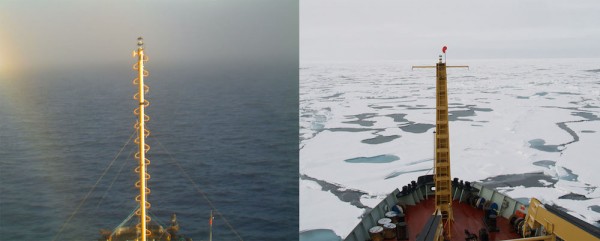Research contributes to more robust Arctic sea ice predictions
February 17, 2015
907-474-2462
02/16/2015

A new study may help policymakers and planners with more accurate Arctic sea ice predictions.
A group of researchers from the University of Alaska Fairbanks International Arctic Research Center and IARC’s Scenarios Network for Alaska and Arctic Planning examined 35 global climate models, the most powerful tools for assessing the future trajectory of Arctic sea ice cover.
Model simulations are the basis for projections of future changes in Arctic sea ice, so it is crucial that model outputs are credible. By comparing the models to the past observational data, or hindcast simulations, the researchers selected subsets of more accurate models to find better future projections of Arctic sea ice extent.
The study highlights the importance of seasonal trends of sea ice. Observational data from 1979 to 2013 show greatly reduced sea ice cover in June through October. They also show that sea ice maximum is reached in March to April, and the trend is much smaller for the maximum ice than for the minimum ice. The models with more realistic hindcast simulations capture the observed trend more accurately and project an earlier loss of summer sea ice, by the 2040s and even as early as 2034.
The study also uniquely examined sudden ice loss events, such as occurred in 2007 and 2012, through the historical period and model projections from 2014 through 2099. The results show that sudden sea ice losses, occurring over a year or two, are often followed by a decade or more of little loss. These sudden ice loss events account for between half and all of the net loss of sea ice extent in the climate models. Recent observational data show a similar behavior.
The group also created an application for exploring sea ice data: http://shiny.snap.uaf.edu/sea_ice_coverage/.
Accurate output of model simulations is essential for policymakers and planners, as changes in Arctic sea ice may have consequences for marine ecosystems, adjacent land areas, and access to the Arctic.
“Arctic sea ice is going to go away sooner than the average of all models would lead us to believe,” noted one of the authors, IARC scientist John Walsh. “More reliable models say sea ice will go away quicker. This can impact many sectors, such as shipping industry,” he said.
Tracy Rogers of IARC, the first author of the paper, echoed the significance of the work. “I think that any policymakers looking to understand future Arctic conditions, especially if they are considering Arctic marine safety and shipping, must use climate models, or at least, analysis on climate models, to do that,” he said.

The study was published in the journal Polar Geography. To read the paper, “Arctic sea ice: use of observational data and model hindcasts to refine future projections of ice extent,” go here.
ADDITIONAL CONTACTS: John Walsh, 907-474-2677, jwalsh@iarc.uaf.edu; Tracy Rogers, 907- 750-5720, tsrogers@alaska.edu
YB/2-17-15/199-15


